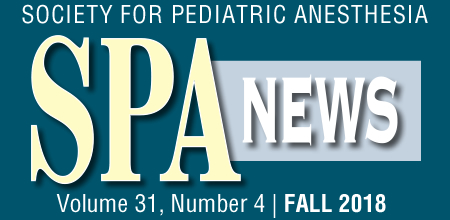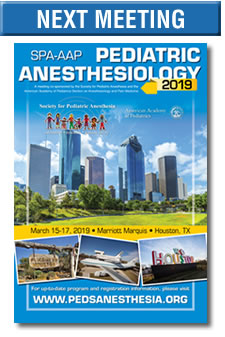meeting reviews
Session 1: The Chest…And All That’s in It
 Reviewed by Petrus Paulus Steyn, MB, ChB
Reviewed by Petrus Paulus Steyn, MB, ChB
Temple University Hospital
Not All Pulmonary Hypertension is Created Equal
In this session, a case presentation was used to discuss the classification of pulmonary hypertension (PH), risk stratification of patients with pulmonary hypertension undergoing procedures and peri-operative management goals.
Chinwe C. Unegbu, MD (Children’s National Health System) discussed a two-year-old child presenting with a suspected Pulmonary Hypertensive (PH) crisis. History included syncopal episodes, an inability to keep up with his peers, cyanotic spells, periorbital edema, abdominal fullness on examination and dilated IVC, RA and RV on echocardiography. Upon admission the child was initiated on Sildenafil (cGMP pathway medication) and Milrinone (inodilator). Following PICC placement, the patient was started on treprostinil.
The child was prepared for cardiac catheterization. Cardiac catheterization is preferably performed before the initiation of vasodilator therapy to provide definitive information of hemodynamics and pulmonary vascular reactivity. Dr. Unegbu noted that this almost never happens as children who present with PH are typically too ill to justify staying treatment until testing occurs.
Dr. Unegbu touched on the hospitalization trends for pediatric PH, noting that childhood PH represented 0.13% of all pediatric hospitalizations, had high all-cause mortality and hospital charges. More than half of the PH population did not have associated congenital heart disease (CHD)1.
Heterogeneity of pediatric PH, including insults on pulmonary circulation, developmental abnormalities of the growing lung versus genetic and other multifactorial abnormalities made classification systems for PH less applicable for the clinical management of children with PH. This led Cerro Et Al to divide pediatric pulmonary hypertensive vascular disease into 10 broad categories2. Dr. Unegbu noted that the idea of this system is to guide diagnostic and clinical investigation and to create study models that may improve our understanding of disease pathogenesis.
Dr. Unegbu briefly discussed the difference between PH and Pulmonary Hypertensive Vascular Disease (PVHD), stating that PVHD refers to patients who have single ventricle non pulsatile pulmonary flow conditions, like in the instance of a pulmonary artery to caval connection.
Pulmonary Hypertension (PH) is classified into:
- Pulmonary Arterial Hypertension (PAH)
1.1 Idiopathic
1.2 Heritable
1.3 Drug/Toxin Induced
1.4 Associated Pulmonary Arterial Hypertension
1.4.1 Connective Tissue Disease
1.4.2 HIV
1.4.3 Portal Hypertension
1.4.4 Congenital Heart Disease
1.4.5 Schistosomiasis
1.4.6 Chronic Hemolytic Anemia
1.5 *Pulmonary Venooclusive Disease
1.6 *Persistent Pulmonary Hypertension due to Left Heart disease - PH due to Left Heart Disease
- PH due to lung diseases and/or Hypoxia
- Chronic Thromboembolic PH
- PH with unclear multifactorial mechanisms
Dr. Unegbu highlighted the difference in definition between PH, PAH, Idiopathic Pulmonary Arterial Hypertension and Pulmonary Vascular Hypertensive Disease (PVHD). PH is defined as a mean Pulmonary Arterial Pressure of equal or more than 25mmHg in children older than 3 years of age as measure at sea level whereas PVHD is a broad category that includes PAH in subjects with an elevated Trans-Pulmonary Gradient or a high Pulmonary Vascular Resistance Index (PVRI).
Dr. Unegbu cited three studies that highlighted that non cardiac surgery in patients with PH/PHVD carried a risk of arrest between 1.2-6% and a risk of Major Adverse Cardiac Event (MACE) up to 20%. The planned cardiac catheterization for our 2-year-old patient needed careful risk stratification.
Dr. Unegbu discussed twelve important elements to consider and how each could point to higher risk for peri-procedural MACE. From the patient’s history, syncopal episodes, failure to thrive, a patient who fatigue easier than his/her peers, age less than one year, comorbid limited cardiac reserve and escalating oxygen requirements. Supra-systemic pulmonary artery pressures, right ventricle dysfunction as seen on echocardiogram, elevated BNP and cardiac catheter data showing right atrial pressures higher than 10mmHg with a CI of less than two are all individual risk factors for peri-procedural cardiac complications. Procedural factors also matter. Emergencies, longer cases, cardiac catheterization in itself and major surgeries are all higher risk endeavors.
According to Dr. Unegbu, one has to understand that the pathophysiology of PH and PVHD represents an imbalance between vasodilator pathways, where nitrous oxide, vasoactive intestinal peptide and prostacyclin are deficient, and vasoactive pathways, where endotelin-1 and serotonin are overtly abundant. This complex imbalance leads to vasoconstriction, thrombosis and pulmonary vascular remodeling.
Dr. Unegbu concluded her talk by discussing the anesthetic management goals for a child with PH and the management of a PH crisis. She stressed that there be no interruption of pulmonary vasodilator therapy, to minimize NPO times, to ensure immediate access to advanced therapies like ECMO and that the most experienced surgeon and anesthesiologist take care of the child.
She advised a balanced multimodal induction with a view to blunting the sympathetic response and to initiate dopamine before induction. Ventilation should be tailored to maintain FRC and reduce pulmonary vascular reduction.
The two-year-old child whom Dr. Unegbu presented developed a pulmonary crisis with hypoxia, hypotension and decrease pulmonary compliance shortly after the procedure was completed. The key management included sedation, paralysis, clearing the endotracheal tube with suctioning and starting inhaled nitric oxide. Despite these interventions, the child became more and more hemodynamically unstable. The child was started on VA ECMO and was bridged to recovery within two days.
Dr. Unegbu concluded her talk by discussing the pros and cons of each medication used in the management of pulmonary hypertension. Like inhaled prostaglandin analogues, inhaled nitric oxide also decreases pulmonary vascular resistance but does not build up in tissues. Dopamine is useful for inotropic support but should be balanced against increases in heart rate and negative effects on right ventricle filling. The inodilator, milirone, can cause unwanted hypotension and negatively affect coronary perfusion pressure. Vasopressin favorably improves coronary perfusion pressures (CPP) and decreases pulmonary vascular resistance. Phenylephrine and epinephrine also improves CPP but increases PVR. The B2 mediated isoproterenol is helpful to decrease PVR but will increase HR and subsequently adversely affect RV filling.
Management of Mediastinal Masses
In this session, Jennifer K. Lee, MD (John Hopkins Children’s Center) discussed common etiologies for anterior mediastinal masses in children, their hemodynamic effects in this patient population and how to formulate an anesthetic plan for children who present for surgery with a mediastinal mass. Children most commonly present for a biopsy albeit of the mass itself or lymph nodes.
There is no anatomic or facial plane that separate the three mediastinal compartments, and masses easily cross compartments. Children have more compliant airway structures, smaller intrathoracic volumes and smaller cardiovascular structures. Therefore, intrathoracic masses have more profound hemodynamic effects in children than adults. Dr. Lee noted that in children, mediastinal masses commonly present in the anterior compartment, are central, grow quickly and can severely disrupt intrathoracic pressure gradients.
Interestingly, the majority of mediastinal masses seen in children between 1 and 19 years of age represent Hodgkin or Non-Hodgkin Lymphoma. However, Acute Lymphoblastic Leukemia (ALL) is a significant risk factor for developing a mediastinal mass.
Patients may present with shortness of breath, a cough or frank superior vena cava syndrome. Up to 26% of patients may be completely asymptomatic. Dr. Lee stressed that it is important to remember that the extent of tracheal area compression, as seen on imaging, has poor correlation with presenting symptoms. In a study looking at 38 children with mediastinal masses who received anesthesia, four children who had significant airway, great vessel or cardiac compression on imaging were asymptomatic. Conversely, eight of the children who were symptomatic had no evidence of mass effects on imaging3. Absence of symptoms should not be reassuring.
Respiratory complications during intravenous anesthesia include unplanned intubation, naloxone/flumazenil reversal, bronchospasm, apnea, desaturation with emesis or desaturation that requires repositioning. In a study of 117 children, 10 of the children had respiratory anesthetic complications and 6 of these were from a propofol based anesthetic4.
Dr. Lee discussed the risk factors for developing peri-operative respiratory anesthetic complications; notably great vessel compression, mainstem bronchus compression, orthopnea and upper body edema. ALL are considered an independent risk factor for developing complications during anesthesia.
Non-Hodgkin Lymphoma with tracheal and vascular compression, greater tumor bulk and more than three respiratory symptoms upon presentation are risk factors for a child developing complications during general anesthesia with intubation. These complications can include worsening airway, superior vena cava and atrial obstruction, pericardial effusions and cardiac arrest.
Preoperative evaluation prior to biopsy should include an echocardiogram, especially if the patient is symptomatic. Dr. Lee recommended obtaining a thoracic CT, even in asymptomatic patients. Pulmonary function testing is rarely practical but may predict airway collapse. Anesthesiologists should be part of the multi-disciplinary discussion about pre-operative (pre-diagnostic) steroids. Steroids may reduce the risk of airway compression but may obscure the diagnosis or lead to inaccurate diagnosis.
Preoperative discussion with the surgical team is important to establish if diagnosis can be made without a direct biopsy or with a minimally invasive technique. A minimally invasive approach may include sampling tissue outside the mass, pleurocentesis, pericardiocentesis or bone marrow biopsy. It is also important to discuss if general anesthesia, sedation or local anesthesia is required and if distraction techniques and child life will be employed. It is important to avoid repeat procedures and to ensure that a pathologist is available to receive the specimen. Everyone involved needs to understand the expected level of sedation and the exact position of the mass.
Dr. Lee discussed a simple pre-operative decision tree for anesthesia where local anesthesia, with or without sedation, should be considered if the child presented with respiratory symptoms or tracheal/cardiovascular compression on a thoracic CT.
Dr. Lee was adamant that the surgeons should be present for induction. She stressed the importance of a shared mental model and that the entire team should be aware of the exact plans of action in the event of a cardiopulmonary emergency. Heliox should be setup in the room and a change of position plan should be discussed. Typically, the child is kept in a semi-fowlers position. Cardiopulmonary bypass on standby is not a complete or adequate plan! An intensive care bed should be on standby.
Dr. Lee concluded her discussion by emphasizing again the need for a preoperative thoracic CT. She again promoted direct communication with surgeons, oncologists, and the entire peri-operative team. The audience was advised to avoid general anesthesia if possible and to have well-defined plans of action in the event of a cardiopulmonary emergency.
Tracheoesophageal Fistula, Congenital Diaphragmatic Hernia, and Lung Isolation in Infants
Rebecca Margolis, DO (Children’s Hospital of Los Angeles) discussed current trends in the management of tracheoesophageal fistula and congenital diaphragmatic hernias. She touched on why infants are more prone to hypoxemia during one lung ventilation and how to manage the hypoxemia. Dr. Margolis also compared different lung isolation techniques.
Left sided postero-lateral diaphragmatic hernias remain the most common followed by anterior hernias of Morgagni. Right sided postero-lateral diaphragmatic hernias are much less common. Liver within the chest is a significant predictor for death. CDH is syndromically associated with CHARGE, Cornelia De Lange, Bieckwidth-Wiedeman and Trisomy 13, 18 and 21.
Newborns with CDH develop Pulmonary Hypertension (PH) as described by a dual-hit hypothesis where the injury relates to more than just external compression of the abdominal content on the lungs. The hypothesis focuses on a decreased number of pulmonary arteries, less available receptors for vasodilation, abnormal arterioles with more vasoconstriction.
Preoperative management goals of congenital diaphragmatic hernias include avoiding mask ventilation, intubating the patient as soon as possible and providing gentle ventilation with permissive hypercapnia. ECMO or high flow oscillating ventilation should be considered if peak inspiratory pressures are above 28 cmH20. The goal for permissive hypercapnia would be to achieve a PaCO2 between 50 and 70cmH2O. Continuous gastric suctioning should be performed. Blood pressure support is only indicated if pre-ductal O2 saturation falls to below 80%. The most severe intraoperative complications include intra-abdominal compartment syndrome, tension pneumothorax and pulmonary hypertensive crisis.
In the most severe cases ECMO may confer a higher survival advantage but comes at the price of more surgical complications. It remains unclear if patients should undergo surgery before ECMO; and if ECMO is used what the best time for it would be. Kays et Al studied the worst patients with liver-up congenital diaphragmatic hernias and reported that children who underwent repair before ECMO had 95% survival vs 69% survival rates5.
Minimally invasive surgery for CDH was discussed. It shows promise for lower rates of post-operative death and lung isolation is not needed as the affected lung is so hypoplastic. It does, however, have a high rate of hernia recurrence.
Interestingly, fetal endoscopic tracheal occlusion or FETO, rather than expectant management during pregnancy, may confer a survival advantage for the most severe patients6.
Dr. Margolis went on to discuss the management of Tracheoesophageal fistulas (TEF). Type C TEF is by far the most common variety, where 11% of fistulas are below or less than 1cm from the carina. During the preoperative work up it is important to look for associated congenital anomalies, especially cardiac, gastrointestinal, genitourinary and vertebra anomalies7.
Preoperative management includes fluid resuscitation, electrolyte correction and replogle placement in the upper pouch. A replogle is a double-lumen tube inserted through the baby's nostril into the blind-ending oesophageal pouch and is used to drain the saliva. Dr. Margolis stressed the importance of obtaining an echocardiogram as 5% of patients may have right sided aortic arches.
The classic airway management of a TEF includes placing a fogarty embolectomy catheter into the fistula and left mainstem intubation. Thorascopic techniques create better conditions for superior anatomical repair and avoid scoliosis or shoulder girdle weakness from the thoracotomy scar.
Intraoperatively, the loss of end tidal CO2 may signal laceration of the airway, airway secretions, accidental fistula intubation or migration of the fogarty into the airway. Conversely, increasing end tidal CO2 during thoracoscopy may also signal an airway laceration. High thoracic pressure will decrease venous return and cause hypotension.
Finally, Dr. Margolis discussed how a neonate’s soft rib cage, relatively higher oxygen consumption and reduced functionality of their diaphragms leads to easier hypoxemia.
Interestingly, due to the reduced hydrostatic forces between nondependent and dependent lungs, neonates do better with healthy lung up during surgery as it is not pressing on the bed
Dr. Margolis briefly touched on the pitfalls of left mainstem intubation, namely that the bronchial diameter of left mainstem is less than 3mm which makes it hard to suction the operative lung and the operative team has to rely on resorption to off load excess air.
A balloon tipped catheter or an Arndt 5-French bronchial blocker can be used for lung isolation. During placement of either the patient may desaturate. Other concerns are inability to employ continuous positive pressure or suction. The 5-French Arndt has a longer balloon.
Bronchial Blockers require using a smaller endotracheal tube but can be placed alongside the endotracheal tube with direct laryngoscopy with position confirmed after intubation. This allows for ventilation during and before lung isolation.
Dr. Margolis concluded her talk by discussing the salient points for improving oxygenation during one lung ventilation:
- CPAP to operative lung.
- Lateral decubitus position to improve ventilation perfusion matching
- Constantly assessing tidal volumes and peep.
References
- Maxwell BG et al. Trends in Hospitalization for Pediatric Pulmonary Hypertension. Pediatrics. 2015; 136:241-50
- Cerro MJ et al. A consensus approach to the classification of pediatric pulmonary hypertensive vascular disease: Report from the PVRI Pediatric Taskforce, Panama 2011. Pulm Circ. 2011; 1:286-298
- Stricker PA et al. Anesthetic management of children with an anterior mediastinal mass. J Clin Anesth. 2010; 22:159-63
- Anghelescu DL et al. Clinical and diagnostic imaging findings predict anesthetic complications in children presenting with malignant mediastinal masses. Paediatr Anaesth. 2007; 17:1090-8
- Kays DW et al. Improved Survival in Left Liver-Up Congenital Diaphragmatic Hernia by Early Repair Before Extracorporeal Membrane Oxygenation: Optimization of Patient Selection by Multivariate Risk Modeling. J Am Coll Surg. 2016; 222:459-70
- Dekoninck P et al. Results of fetal endoscopic tracheal occlusion for congenital diaphragmatic hernia and the set up of the randomized controlled TOTAL trial. Early Hum Dev. 2011; 87:619-24
- Broemling N et al. Anesthetic management of congenital tracheoesophageal fistula. Paediatr Anaesth. 2011; 21: 1092-1099.






